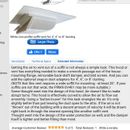Range out soffit
Hello,
I am installing a range hood in my existing home ,It is in the center of my kitchen i have a unfinished second story so i was planning to 90° turn run between joist bay and terminate out soffit with vent I attached a photo of termination, it claims to address the problems associated with soffit venting .Ive considered going down and out crawlspace but dont think its a option since center beam in floor will prevent a clear shot.
GBA Detail Library
A collection of one thousand construction details organized by climate and house part











Replies
Hi Eric.
I am not familiar with that product, but in general the soffit is the last place you would want to vent a kitchen range hood. Not only is there the obvious issue of moisture-rich air being drawn back into the soffit vents (if you have them), but it can also cause staining and ice dams, or at least icicles.
If you cannot go direct through a kitchen wall, which it sounds like you can't, better options are a gable wall vent or a roof vent.
Maybe the product you attached is the answer, hopefully someone else can speak to it.
In the meantime, here are a couple of article that may be helpful, the first is about bathroom exhaust, but much of the venting details would apply to your kitchen exhaust situation, the second is about makeup air, which you may also need to consider.
Bathroom Exhaust Fans
Makeup Air for Kitchen Exhaust
I’d avoid soffit venting. That vent you posted looks like it would offer a fair amount of flow restriction too, which is a bad thing — especially for low pressure vents like a range hood.
I had a similar issue when venting my own range hood. I don’t like recirculating hoods, so when I was remodeling the room on the opposite side of the wall from our kitchen, I vented to the outdoors. I just went straight up and out the roof using a roof vent. This works fine, and has no issues. Just be sure to get the roof vent’s actual vent area up above the likely snow level.
Bill
Wish i could upstairs will be finished .
On a recent project we were dealing with a similar decision (venting out the soffit or a more complicated run up to the roof). We went with the roof exhaust, it was a much more involved and expensive install but it resulted in a much less restrictive ducting plan and avoided the concerns we had with moist air exhausting under a substantial overhang.
The cap you linked solved a major issue with soffit range venting (that is, the tendency to install a cap meant for a roof or wall on an angled soffit) but it doesn't address the larger issue - a soffit just isn't a great place to vent a range.
If you don't have another choice go for it and report back in a couple of years. I've certainly seen ducting that I find more objectionable than your solution that worked well enough!
I've done a range vent like that before, as others have mentioned, not ideal but can work. The place in question had very small overhangs and no soffit vents.
My biggest beef with it was it is pretty restrictive. The hood itself is bad plus you need a sharp 90 to connect to it from the attic. This was for a 300cfm OTR, so not much flow but still measured close to 1" wc with only one more 90 in the rest of the ducting.
The flapper on them do not seal all that well, so don't expect any passive house type of performance out of it.
I haven't noticed any ice melt issues on the roof. Could definitely be an issue with a low slope roof with larger overhangs.
P.S. If you do have soffit vents, one way to keep the hot air out of the roof is to block off the section near the cap.
是的我认为生病有一个运行在矿山高er cfm.